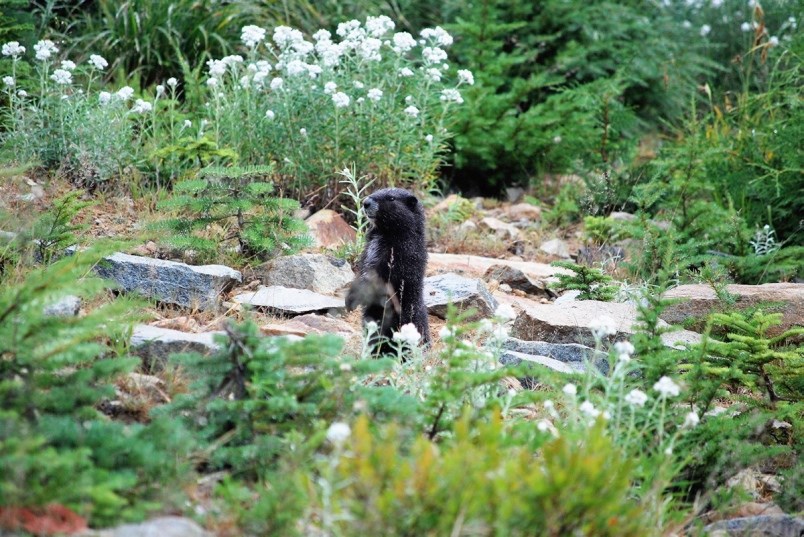The beaver or polar bear might be symbols of Canada, but there are 308 species of mammals, plants and invertebrates that are found only within our borders, and most are in danger of disappearing forever, conservationists say.
British Columbia has 105 of those species — more than any other province — and Â鶹´«Ã½Ó³»Island is considered a hotspot for the unique life forms, according to Ours To Save, a report by NatureServe and the Nature Conservancy of Canada.
The first comprehensive survey of uniquely Canadian species reveals that many are vulnerable to extinction.
The Â鶹´«Ã½Ó³»Island marmot is the Island’s best known native mammal, and also one of the most endangered in Canada.
From fewer than 30 animals in a handful of colonies in 2003, the marmot is making a slow comeback with about 200 animals in about 20 mountain colonies counted last year, most in the Mount Washington and Nanaimo Lakes areas, according to the Marmot Recovery Foundation.
Researchers are watching dens for fresh population counts, as the marmots usually give birth during the first few weeks in June.
But there are other Island native species that are also in a critical state, according to the report. Some have not been documented for decades, are classified as endangered and may be extinct, said the report.
The Â鶹´«Ã½Ó³»Island Blue (Plebejus saepiolus insulanus) is a butterfly last seen in 1979 near Victoria. The latest reports from the Committee on the Status of Endangered Wildlife in Canada said there has not been any discoveries since and the declines were likely due to threats to habitat, including residential housing and the encroachment of invasive plants.
The Â鶹´«Ã½Ó³»Island wolverine (Gulo gulo vancouverensis) is a subspecies of the wolverine, the largest terrestrial member of the weasel family. The Island wolverine has not been seen since 1992 and the population is believed to have either died out or left the Island to join populations on the mainland.
The wolverine is currently on the province’s “red list,” which is defined as any species at risk of being lost or shifted to other areas.
Wolverines tend to be found at higher elevations and alpine areas with deep snowpacks.
The Â鶹´«Ã½Ó³»Island water shrew (Sorex navigator brooksi) is considered imperiled. It is a subspecies of the shrew, but is larger and known for features to accommodate its aquatic lifestyle. There has been no data collected on its populations, but its habitat is thought to have been threatened by logging and other developments along streams.
Populations of the Â鶹´«Ã½Ó³»Island Ermine, a subspecies of the weasel but with a shorter tail, are considered at risk by the province.
The Â鶹´«Ã½Ó³»Island white-tailed ptarmigan is the smallest of the saxatilist subspecies and is considered at risk. It was first described as a subspecies in 1938 and has subtle differences from other ptarmigans in its bill and plumage. It migrates seasonally through the Island’s central mountain ranges from Mount Brenton to Tsitika Mountain.
The Ours to Save report said more than 70 per cent of the nationally native species in B.C. are vascular plants and invertebrates.
It said many of these are on Â鶹´«Ã½Ó³»Island, Haida Gwaii and other islands that likely acted as a refuge during the last period of glaciation.
Among those on Haida Gwaii are the Queen Charlotte Hairy Woodpecker (Dryobates villosus picoideus), Queen Charlotte Pine Grosbeak (Pinicola enucleator carlottae) and several subspecies of the Townsend’s Vole (Microtus townsendii).
Dawson Caribou (Rangifer tarandus dawsoni) was once restricted to Graham Island on Haida Gwaii, but is now extinct. The report said genetic analysis indicates it might not have been a separate caribou subspecies.
Identifying Canada’s native species and the places where they live is an essential effort in protecting them from extinction, said the report.
Mammals listed also include the maritime shrew, which lives in wetlands in New Brunswick and Nova Scotia, the eastern wolf, which lives in Algonquin Park, and the high Arctic’s Peary caribou. Birds include Harris’ sparrow, the only songbird that breeds exclusively in Canada. Invertebrates, such as the tiny maritime ringlet butterfly, make up almost half of the species listed in the report. A variety of flowering plants are also included.
The report will be used by Nature Conservancy of Canada and other groups for conservation actions and habitat protection. “No other nation can protect this group of all-Canadian species,” said Dan Kraus, senior conservation biologist for Nature Conservancy of Canada. “Their conservation is completely up to Canadians. Protecting these species is Canada’s priority in the fight against global biodiversity loss. The consequence of our failure to conserve them is their extinction.”
BY THE NUMBERS
Canada’s endemic species, number by province:
• British Columbia: 105
• Quebec: 57
• Alberta: 54
• Yukon: 43
• Newfoundland and Labrador 40
• Saskatchewan: 36
• Northwest Territories: 32
• Manitoba: 31
• Nunavut: 29
• Nova Scotia: 28
• Ontario: 28
• New Brunswick: 17
• Prince Edward Island: 7
Read more from the



